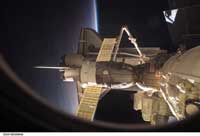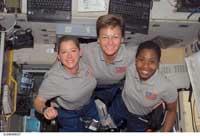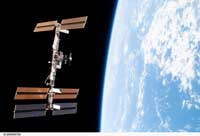La Station Spatiale Internationale: l’humanité va prendre pied dans l’espace Understand article
In the first of two articles, Shamim Hartevelt-Velani and Carl Walker from the European Space Agency take us on a trip to the International Space Station.
What is the ISS?
Imagine an array of bright solar panels fanning out from a central support about 100 metres in length. At various locations along the support, cylindrical pressurised modules are attached. Astronauts live and work inside these modules. Some modules are laboratories; others provide a living space for the crew, including a kitchen and an exercise area. Additional modules provide storage facilities for water, food, equipment and experiments, and house systems for recycling air and water, as well as a lavatory. Nodes connect the different modules and provide a docking port for vehicles arriving from Earth.

of space and Earth’s horizon, this
photo by a crew member of the
ISS shows the docked Space
Shuttle Discovery (STS-120)
and a Soyuz spacecraft
Image courtesy of ESA/NASA
Science fiction? No, this amazing structure has been fact since 20 November 1998, when the first building block called ‘Zarya’ (‘Sunrise’ in Russian) was launched into orbit by a Russian Proton rocket from Baikonur in Kazakhstan. The International Space Station (ISS) is the biggest man-made structure ever to fly in space. It is a collaboration between the European Space Agency (ESA)w1, the US National Aeronautical and Space Administration (NASA)w2, the Russian Federal Space Agency (Roscosmos)w3, the Canadian Space Agency (CSA)w4 and the Japan Aerospace Exploration Agency (JAXA)w5. The continuing assembly of the station uses the robotic arms of the Space Shuttle and the ISS, as well as the astronauts who help complete the work by performing extravehicular activities (EVAs, or spacewalks) in the vacuum of space.
The ISS provides a unique opportunity to conduct pioneering investigations in numerous scientific fields. Compared with earlier space stations, the ISS provides substantially more opportunities for carrying out dozens of experiments, either on racks inside the Station or at special external attachment points. This is because the ISS has a larger internal volume, more available computing power, more electrical power and an extended lifetime that allows scientists to conduct experiments over longer periods with a continual flow of data.
Gravity affects almost everything we do on Earth. In orbit, the effects of this force virtually disappear and are replaced by microgravity conditions, or ‘weightlessness’. Astronauts float around, able to carry huge pieces of equipment with ease. In these conditions, scientists can test and modify existing theories, which could lead to new discoveries and advances.
Travelling to the ISS
From May 2009, the ISS will be permanently manned by a crew of six astronauts from the USA, Canada, Japan, Russia and ESA. The crews are exchanged throughout the year, but the average stay is six months. Crews are made up of a mixture of nationalities, the combination of which depends on agreements between the governments. All crews must have a good understanding of spoken and written English and Russian.

commander (left); Peggy Whitson,
Expedition 16 commander; and
Stephanie Wilson, STS-120
mission specialist, pose for a
photo in the Zvezda Service
Module of the ISS while Space
Shuttle Discovery is docked
with the Station
Image courtesy of ESA/NASA
The crew reach the ISS either in a Russian Soyuz capsule, launched from Baikonur, or in an American Space Shuttle, launched from Cape Canaveral in Florida, USA. From Earth, it takes about ten minutes for the astronauts to reach orbit.
During the launch of a Space Shuttle, there are loud noises and huge vibrations as the main engines burn liquid hydrogen and oxygen. After lift-off, the speed quickly increases, and the rapid acceleration squashes the astronauts into their seats as acceleration forces increase from 1 g to as much as 4 g – similar to some of the fastest roller coasters.
The Shuttle soon reaches 10 km above sea level, the cruising altitude of airliners. The temperature drops to below zero and it is also at this point that the greatest air resistance with the atmosphere is encountered. As the Shuttle soars still higher, the horizon curves and the astronauts first experience the darkness of space. After two minutes, the Shuttle reaches an altitude of 45 km and is travelling at around 4.5 times the speed of sound.
Four minutes later, the Shuttle reaches an altitude of 130 km and is travelling at 15 times the speed of sound. The central propellant tank is now empty and separates, eventually burning up in the atmosphere. The main engines are switched off, but the Shuttle continues to move through space because now there is no air resistance. Objects inside appear to become weightless and anything not firmly strapped down begins to float.
The vibrations end and silence surrounds the spacecraft. The Shuttle reaches a speed of 22 times the speed of sound (28 000 km per hour) and an altitude of nearly 400 km; it is now in the same orbital plane as the ISS. The Shuttle begins to chase the Station – it is 10 000 km behind and lower in altitude and two more days are required for the rendezvous and docking, to make sure all the system checks are finalised. Docking takes place very slowly to avoid any accidents.
Research on board

2007 from the Space Shuttle
Image courtesy of ESA/NASA
Our current understanding of the life sciences, physics and chemistry is almost entirely based on observations and theories influenced by the ever-present force of gravity. On the ISS, research carried out in an environment of weightlessness allows scientists to test and modify existing theories.
For example, the properties of materials are determined by their fine structure and influenced by the imperfections that are formed mainly during the transition from liquid to solid. This process is influenced in very complex ways by gravity. By studying solidification in microgravity, it is possible to better understand how gravity affects the process back on Earth. As a result of this space-based research, engineers can improve the manufacturing processes used on Earth to produce cheaper, stronger and more reliable castings.
Astronauts also carry out experiments in biology, medicine and human physiology. ESA’s activities in this research are currently focused on the effect of gravity on development and maintenance of bone tissue, as well as the influence of medication. Early long-term spaceflights revealed not only that living in space conditions led to loss of bone mass, but also that this loss varied from very little to as much as 20% of bone minerals after 6-8 months in space.
It is common knowledge that loss of bone quality is the main characteristic in osteoporosis sufferers on Earth. The same loss of bone mass and quality can also be observed in healthy space crews. By doing research into these similar problems, we have a better chance of solving both. Research over the past decade has made significant progress, and so much more is known today than ten years ago. Experiments in space are helping us to understand the maintenance of bones, and may help space crews to maintain their bone quality while spending more time in a weightless environment.
In the next issue of Science in School, read about how astronauts live in space and how their bodies adapt to conditions of microgravity.
Web References
- w1 – For more information about the European Space Agency, see: www.esa.int. See below for information about ESA’s education resources.
- w2 – For more information about NASA, see: www.nasa.gov
- w3 – For more information about Roscosmos, see: www.roscosmos.ru
- w4 – For more information about the Canadian Space Agency, see: www.space.gc.ca
- w5 – For more information about the Japan Aerospace Exploration Agency, see: www.jaxa.jp/index_e.html
Resources
- Warmbein B (2007) Down to Earth: interview with Thomas Reiter. Science in School 5: 19-23.
- Wegener A-L (2008) Laboratory in space: interview with Bernardo Patti. Science in School 8: 8-12.
- Williams A (2008) The Automated Transfer Vehicle – supporting Europe in space. Science in School 8: 14-20.
- Many hundreds of images, videos and animations about human space flight are available on the ESA website and can be used for education purposes: www.esa.int/esa-mmg/mmg.pl?collection=Human+Spaceflight
- A printed ISS Education Kit for both primary- and secondary-school teachers is available in all 12 ESA languages. The kits are based on all the fascinating activities involved in building, working and living on board the ISS, and provide background information and exercises for classroom teaching. They are available to all school teachers in ESA member states and can be ordered free online: www.esa.int/spaceflight/education
- An interactive version of the ISS Education Kit is available at: www.esa.int/spaceflight/education
- ‘Space Robotics’, the latest in a series of four ISS DVD lessons covering topics relating to European school curricula and based on Project Zero Gravity, is now available.
- A new DVD on the physics involved in the Automated Transfer Vehicle (ATV) is due to be released later this year. DVDs can be ordered free by teachers: www.esa.int/spaceflight/education
- ESA is also developing a series of online lessons for primary- and secondary-school students and their teachers. See: www.esa.int/SPECIALS/Lessons_online
- A new Space Exploration Kit 1 for primary schools will be released in 2008.
- European Space Agency Education website: www.esa.int/education
- European Space Agency Human Spaceflight Education website: www.esa.int/esaHS/education.html





